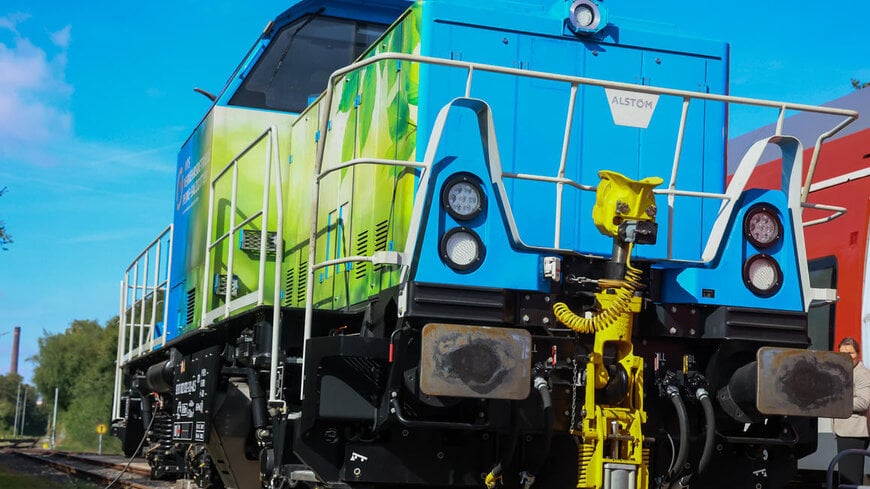railway-international.com
22
'25
Written on Modified on
World premiere: Alstom shunting locomotive runs on hydrogen in Salzgitter, Germany
A modernised shunting locomotive with a hydrogen drive saves up to 3,000 tonnes of CO2 over a remaining service life of 15 to 20 years, which is equivalent to the emissions of up to 650 cars.
www.alstom.com

For the first time ever, a shunting locomotive was retrofitted from diesel to hydrogen propulsion.
Alstom, global leader in smart sustainable mobility solutions, completed the world's first journey with a shunting locomotive converted from diesel to hydrogen drive in Salzgitter, Germany. Alstom is developing the modernisation solution for existing locomotives together with VPS Verkehrsbetriebe Peine-Salzgitter GmbH (VPS, subsidiary of Salzgitter AG), WTZ Roßlau gGmbH, TU Braunschweig and the associated partner Fraunhofer Institute for Surface Engineering and Thin Films. The project is supported by the city of Salzgitter, which is contributing funding totalling 1.5 million euros from the 50 million euros in structural aid that the city received from the state of Lower Saxony.
The modernisation solution presented at the company's Salzgitter site is a milestone in a joint project for the decarbonisation of shunting traffic. After the conversion, the vehicle engine will be powered by direct, CO2-free combustion of hydrogen. The industrial test operation, which is now beginning at the Salzgitter Group's steel-producing companies, is expected to run until October 2025. The partners expect this unique, practical operation to provide important insights into the suitability of this technology for everyday use. The experience gained will be analysed to investigate how it can be incorporated into a series solution. The project will be completed in autumn 2025 and the locomotive will then be returned to its original condition.
The CO2 savings potential of converting shunting locomotives from diesel to hydrogen drive is huge. VPS, for example, operates 42 locomotives for the transport of ore and coal, pig iron and steel products within the production network. There are around 1,000 diesel shunting locomotives in use in Germany and around 4,000 across Europe. The average service life of a diesel shunting locomotive is 50 to 70 years and it emits around 150 tonnes of CO2 per year. A modernised shunting locomotive with a hydrogen drive saves up to 3,000 tonnes of CO2 over a remaining service life of 15 to 20 years, which is equivalent to the emissions of up to 650 cars. You would have to plant 200,000 trees to save this amount of CO2.
www.alstom.com
Alstom, global leader in smart sustainable mobility solutions, completed the world's first journey with a shunting locomotive converted from diesel to hydrogen drive in Salzgitter, Germany. Alstom is developing the modernisation solution for existing locomotives together with VPS Verkehrsbetriebe Peine-Salzgitter GmbH (VPS, subsidiary of Salzgitter AG), WTZ Roßlau gGmbH, TU Braunschweig and the associated partner Fraunhofer Institute for Surface Engineering and Thin Films. The project is supported by the city of Salzgitter, which is contributing funding totalling 1.5 million euros from the 50 million euros in structural aid that the city received from the state of Lower Saxony.
The modernisation solution presented at the company's Salzgitter site is a milestone in a joint project for the decarbonisation of shunting traffic. After the conversion, the vehicle engine will be powered by direct, CO2-free combustion of hydrogen. The industrial test operation, which is now beginning at the Salzgitter Group's steel-producing companies, is expected to run until October 2025. The partners expect this unique, practical operation to provide important insights into the suitability of this technology for everyday use. The experience gained will be analysed to investigate how it can be incorporated into a series solution. The project will be completed in autumn 2025 and the locomotive will then be returned to its original condition.
The CO2 savings potential of converting shunting locomotives from diesel to hydrogen drive is huge. VPS, for example, operates 42 locomotives for the transport of ore and coal, pig iron and steel products within the production network. There are around 1,000 diesel shunting locomotives in use in Germany and around 4,000 across Europe. The average service life of a diesel shunting locomotive is 50 to 70 years and it emits around 150 tonnes of CO2 per year. A modernised shunting locomotive with a hydrogen drive saves up to 3,000 tonnes of CO2 over a remaining service life of 15 to 20 years, which is equivalent to the emissions of up to 650 cars. You would have to plant 200,000 trees to save this amount of CO2.
www.alstom.com

